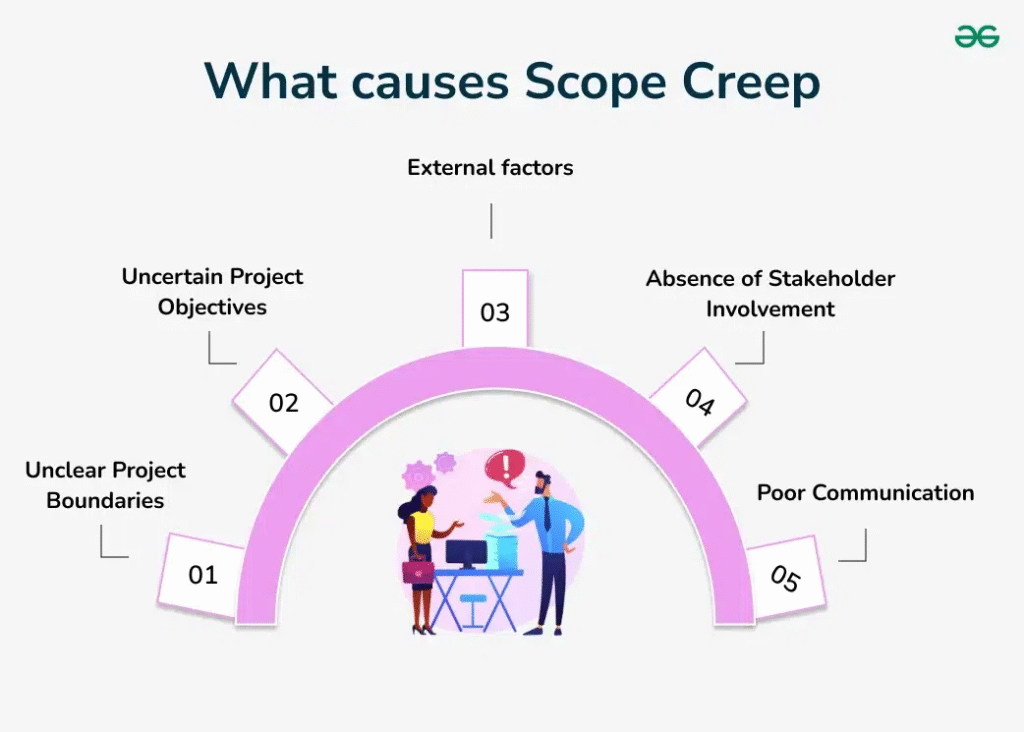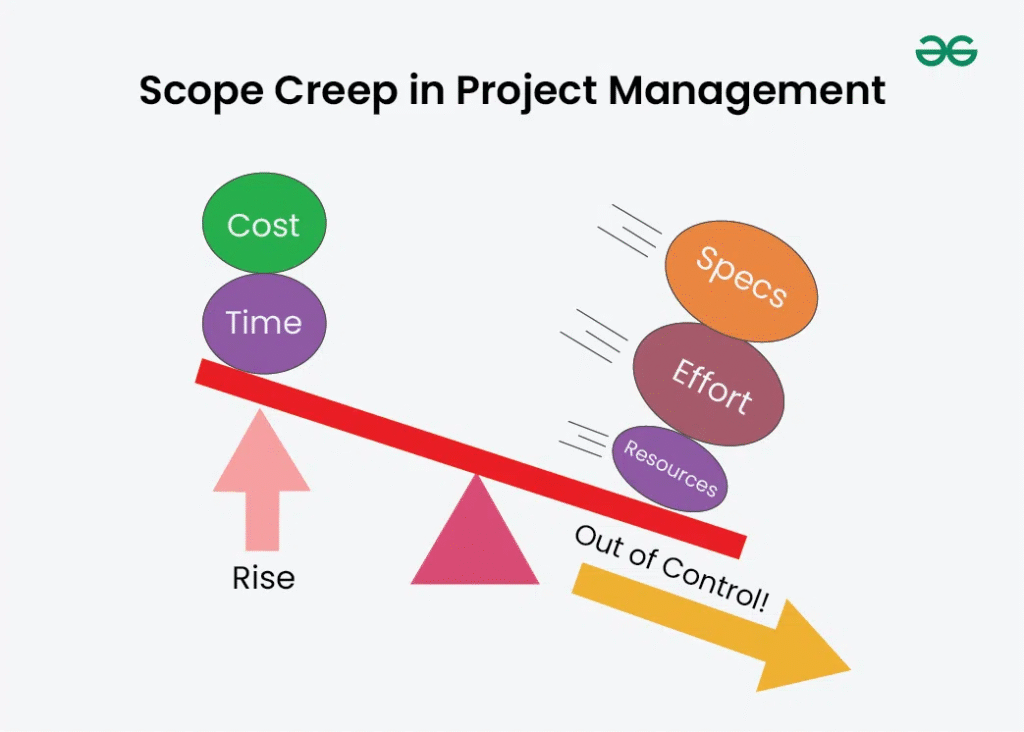Construction projects often like a race against time and money. You might start with a solid plan. But the requests for extra features, like upgraded lighting, custom finishes, or reinforced walls adds up an extra budget. Suddenly, your schedule is delayed, and your budget is stretched thin. This challenge is called scope creep. It affects contractors across residential, commercial, and industrial jobs, often eating into profits and straining client relationships. Without proper systems, even experienced builders can lose control. As specialists in change order estimating, we’ve seen how unplanned changes derail projects. This guide explains scope creep, why it happens, and how smart estimating strategies can protect your bottom line.
Scope Creep in Construction
Scope creep happens when a project expands beyond your agreed contract and without extra time, money, or resources. For instance, a client may request for an additional room, premium flooring, or a redesign in mid-project. These “small” changes accumulate, creating significant financial and scheduling problems.
Research at industrial level shows that over 50% of construction projects face scope creep, leading to higher costs and longer timelines. For large developments, ignoring scope creep can transform a profitable contract into a financial loss.
Understanding Change Orders in Construction Projects
A change order is an official document which is liable to make changes in the original contract. It includes adjustments to scope, cost, or schedule. It ensures both contractor and client agree on the terms. Think of it as a safety net. Without a change order, contractors end up paying for surprises out of pocket. For instance, if a roofing crew discovers rotten beams, a change order estimating allows the contractor to charge for additional repairs.
Well-prepared construction estimating services can turn change orders into tools for protecting profitability instead of liabilities.
Why Scope Creep Happen
Knowing why scope creep hits helps you stop it. Here’s what causes it:
- Unclear project plans
Vague contracts describing finishes as “nice” or “premium,” create misunderstandings. Clients may expect higher-grade materials that weren’t priced, leading to disputes and additional costs.
- Poor communication
When contractors, architects, and clients don’t have regular communication. Even small details slip through the cracks. A missed update on design changes can snowball into major revisions late in the build.
- Client-driven requests
Homeowners or developers often request for an upgrade such as solar panels, smart systems, or luxury finishes after construction begins. While valuable, these extras expand project scope and impact both cost and schedule.
- Hidden site conditions
Unexpected soil issues, outdated wiring, or concealed plumbing often appear mid-project. These require more labor, materials, and time than originally estimated, driving costs up.
- Weak planning
Skipping a thorough site survey or neglecting early risk assessments sets the stage for last-minute surprises. Contractors then scramble to fix issues that could have been avoided.
Studies show bad planning fuels most project risk management issues. With Estimating’s tools, you’ll spot these traps and avoid budget blowouts.

How Scope Creep Affects Profitability
Scope creep hits hard. It can boost costs by 27% and stretch schedules by a third. Change orders, while needed, disrupt your crew, rush material orders, and frustrate subcontractors. Imagine losing $150,000 on a $1 million job because of unpriced extras. That’s real pain.
In the U.S., change orders cost billions yearly, not counting lost time. For a $2 million store build, scope creep could eat 10-15% of your profit. Delays hit 80% of these projects, making them a third longer. Rushing leads to errors, sparking client fights or lawsuits.
In competitive bidding, contractors must show they can manage change without compromising profit. This is where accurate cost estimating services become a powerful advantage.
How to Stop Scope Creep
You can’t prevent every change, but you can reduce the impact of scope creep with proactive strategies:
- Write detailed contracts
Break down deliverables clearly including specifications, exclusions, and deadlines. Use 3D models, drawings, or visuals to ensure client expectations.
- Implement a change approval process
Every request should be reviewed for cost, schedule, and labor impact before approval. This creates transparency and prevents free work.
- Hold regular client meetings
Weekly updates let you tackle issues early, meet expectations, and keep all parties accountable. Tools like project management apps make tracking decisions easier.
- Perform thorough site checks
Before work begins, identify risks such as poor soil, asbestos, or outdated utilities. These risk assessments added into estimates reduce unpleasant surprises later.
- Train your team to say no in a kind way
Encourage your staff to review requests against contract scope. Explain why certain changes cannot be included without formal approval.
These steps can reduce scope creep by up to 50%, saving both time and money. Contractors seeking affordable construction estimates for contractors and other bids benefit greatly from embedding these protections into every job.

How to Do Change Order Estimating Correctly
Nailing change order estimates protects your profits and reputation. Accurate change order estimating keeps projects profitable and client relationships strong. Here’s how contractors can approach it:
- Record Every Detail
Write down the change date, work needed, costs, and approvals. For example, if a client adds skylights, note labor hours, glass prices, and install time. This clarity avoids fights. A Georgia contractor we helped saved $40,000 in a dispute by showing clear records.
- Strive for Accuracy
Use exact costs, like current labor rates or supplier quotes for pipes. Aim for estimates within 10-15% of real costs. Accurate budget friendly construction quotes build client trust and boost approvals by 30%, per industry data.
- Include All Expenses
Add labor, materials, equipment, and delay costs, like rescheduling a concrete pour. For affordable estimates for contractors, factor in regional issues, like snow delays adding 5% to northern projects.
- Leverage estimating tools
Software like Bluebeam tracks real-time prices, cutting errors. Our clients save 25% on estimating time, freeing you to bid on more jobs.
- Check Contract Clauses Before Estimating
Review project contracts carefully before preparing change order estimates. Knowing which costs are reimbursable ensures your pricing stays accurate and recoverable.
With change order estimating, your estimates will be sharp and fair, making clients choose you again. The scope creep and scope change are given in table below
Scope Change vs Scope Creep:
| Scope Change | Scope Creep |
|---|---|
| An official decision made by the project manager and the client | Where the project scope grows beyond what was originally defined in the statement of work |
| A change to a feature, to expand or reduce its functionality | Almost always lacks proper planning, costing, and approval processes |
| Involves adjusting the cost, budget, other features, or the timeline | Small changes that greatly impact your bottom line |
Pricing Change Orders for Profit
To price change orders, list costs: labor at current rates, materials like steel or tiles, and equipment rentals. Add 10-15% for overhead (e.g., office costs) and a small profit margin. For big changes, like adding HVAC, use past job data for fair prices. Show clients proof, like supplier receipts, to build trust. Change order estimating’s pricing tools recover 90% of extra costs, keeping your project in the black.

Client Success Stories
Real-world results show how smart estimating makes a difference:
- Hotel renovation, Texas: John Miller of Miller Builds faced constant changes during a $1.5 million project. With structured change order estimating, his team priced extras quickly and stayed profitable. “It saved us. We didn’t lose control,” John says.
- Public library, Midwest: A contractor avoided costly overruns by using detailed construction estimates for contractors. The project finished on time and opened doors to more municipal contracts.
- Condo project, Florida: Lisa Brown from Riverfront Projects recalls, “Scope creep was costing us weeks and thousands. The estimating strategies saved us time and kept us on budget.”
These stories prove that accurate estimating transforms challenges into wins.
Act Now to Save Your Profits. Don’t let scope creep steal your next job’s profits. ALM Estimating’s project risk management tools make your bids sharper and projects smoother. Contact us now!
FAQs
Q1. What does scope creep mean in construction?
Scope creep is when the project grows beyond the original plan without adjusting time, cost, or resources. Even small changes can add up, causing delays and extra expenses.
Q2. Why are change orders necessary?
A change order protects both contractor and client. It officially records adjustments to cost, schedule, or scope so there’s no confusion about who pays for added work.
Q3. How does change order estimating support contractors?
Proper change order estimating makes sure every extra cost, labor, materials, or delays are included. This keeps projects profitable and avoids disputes later.
Q4. What usually causes scope creep?
The main reasons are vague contracts, client upgrades during construction, hidden site issues, poor communication, and weak early planning.
Q5. How can contractors control scope creep?
By writing clear contracts, reviewing every change request, holding regular client meetings, and checking sites thoroughly before work starts, contractors can reduce risks and protect profits.
